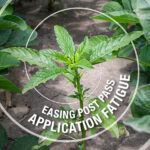Wake Up Soil to Prevent Apple Replant Disease
Prevent apple replant disease, also called soil exhaustion, by controlling nematodes, soil pathogens and planting trees in suitable environments.

Apple replant disease is a common problem in intensive apple production areas. Also called soil exhaustion, the disease happens when growers plant young trees into existing orchards with depleted soil nutrients and increased activity from harmful microorganisms. Vulnerable young trees affected by apple replant disease experience uneven growth, stunting, root damage and reduced root biomass.
Addressing apple replant disease is challenging because it is caused by a complicated combination of nematodes and fungi-like pathogens called oomycetes. When soil is disturbed during replanting, the lack of cover in newly exposed areas allows these microorganisms to multiply more rapidly. Without the buffering effect of organic matter, the result is nutrient-deficient soil teeming with pathogens.
Preventing and treating apple replant disease requires a three-step approach to address the many causal organisms and wake up exhausted soil.
Step 1: Plant Trees in Suitable Environments
The first and most important measure is to carefully select where to plant trees. When possible, plant tolerant rootstock in the grassy spaces between old rows. These sites typically have more organic matter and because there aren’t any old roots, less harmful microorganism activity.
Soil testing is a valuable tool that can help determine how a replant site compares to a new site, as well as to understand the impact of practices like cover crops on soil health.
Step 2: Control Nematodes
Traditionally, growers have used soil fumigation to control nematodes. Although this method effectively treats nematodes, it essentially sterilizes the soil, removing both beneficial and harmful microorganisms. This can contribute to a lack of organic matter and negatively impact long-term soil health.
Instead, consider incorporating cover crops. Cover crops slow nematode activity and add organic matter to the soil, improving overall soil health and structure. In this case, the best choice for cover crops is radishes, canola and mustard. These brassica crops contain a biochemical agent called isothiocyanates that naturally suppresses nematodes and plant pathogens. To improve soil health, consider delaying replanting apple trees for one year to grow cover crops.
Deep tillage before planting cover crops can remove decaying apple roots in orchards with a history of apple replant disease. Eliminating old roots removes the host and reduces nematode pressure in that area. Another option is to apply brassica or mustard seed meals to rows and cover for three weeks after tillage as a natural alternative to fumigation.
Step 3: Control Soil Pathogens
The soil organic matter, health, and structure provided by cover crops also improves the ability of the soil to act as a buffer between plant roots and pathogens. Once new trees are planted, quality fungicides can help combat oomycetes pathogens.
Consider a fungicide application that protects trees from Phytophthora crown rot, collar rot, and root rot, as well as additional soilborne pathogens involved in the apple replant disease complex.
Timely fungicide applications combined with sound agronomic practices can help improve long-term orchard health and sustainable apple production.
2 Min Read
- Apple replant disease, or soil exhaustion, occurs when growers replant trees into depleted soil with increased activity from harmful microorganisms.
- A three-step plan can help growers address nematodes, oomycetes, and organic matter to prevent soil exhaustion.
- Soil testing and orchard history are valuable tools when selecting planting sites.
More Articles About Field Insights
RECOMMENDED FOR YOU
2 Min Read























